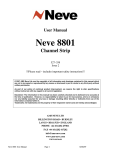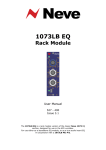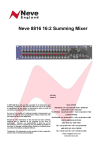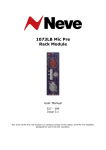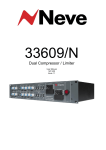Download 1073DPA User Manual
Transcript
1073DPA & 1073DPD Mic Pre-Amplifier User Guide AMS NEVE 1073DPA and 1073DPD Mic Pre_Amplifier User Guide 527 - 349 Issue 3 © 2005 AMS Neve Ltd own the copyright of all information and drawings contained in this manual which are not to be copied or reproduced by any means or disclosed in part or whole to any third party without written permission. HEAD OFFICE As part of our policy of continual product improvement, we reserve the right to alter specifications without notice but with due regard to all current legislation. AMS NEVE PLC • BILLINGTON ROAD • BURNLEY LANCS BB11 5UB • ENGLAND TELEPHONE: +44 (0) 1282 457011 • FAX: +44 (0) 1282 417282 LO N D O N O F F I C E TELEPHONE: +44 (0) 20 7916 2828 • FAX: +44 (0) 20 7916 2827 Disclaimer: The information in this manual has been carefully checked and is believed to be accurate at the time of publication. However, no responsibility is taken by us for inaccuracies, errors or omissions nor any liability assumed for any loss or damage resulting either directly or indirectly from use of the information contained within it. Issue 3 NORTH AMERICAN OFFICES AMS NEVE INC., NEW YORK TEL: +1 (212) 965 1400 • FAX: +1 (212) 965 9306 AMS NEVE INC., HOLLYWOOD TEL: +1 (818) 753 8789 • FAX: +1 (818) 623 4839 e-mail: [email protected] http://www.ams-neve.com 1073DPA & 1073DPD Mic Pre-Amplifier User Guide Contents Introduction 1073DPA 1 1073DPD 1 Dimensions 2 Rack Mounting and Cooling 2 Power Requirements 2 Mains Supply 2 DC Power Supply Indicators 2 Phantom Power 2 Rear Panel Connectors 3 1073DPA 3 1073DPD 3 Amplifier Controls Issue 3 1 4 1073DPA 4 1073DPD 4 DPD Headroom Level Setting 6 Specifications 7 1073DPA 7 1073DPD ADC 7 Page ii 1073DPA & 1073DPD Mic Pre-Amplifier User Guide Introduction 1073DPA The latest addition to the Neve outboard range, the 1073DPA provides two of the world famous Class A Neve 1073 microphone pre-amplifiers. This classic design is a consummate mic pre for recording vocals, guitars and acoustic instruments of all descriptions. 1073DPD Two classic Neve 1073 mic pre-amplifiers are complemented by pristine professional ADCs to capture a performance to any required format. In addition to Neve's famous Class A analogue outputs are a series of digital options including all standard PCM sampling rates up to 192kHz. A unique feature is the Neve DSD output. Analogue insert points are provided ahead of the ADCs. The ultimate analogue circuitry is coupled with superior digital quality making this unit the obvious choice as a front end for recording to workstations. Both of these modules are supplied in a 1U 19" rack-mounting unit. Issue 3 Page 1 1073DPA & 1073DPD Mic Pre-Amplifier User Guide Dimensions Units U Depth mm (inches) Height mm (inches) Approx. Weight kg (lbs) 1073DPA / 1073DPD 1 254 (10) 45 (1.75) 5 (11) Rack Mounting and Cooling The rack units should be installed in a 19" cabinet with access to the front and rear. No specific air conditioning is required for the racks, provided that there is a free flow of air through the rack from front to back, and that the ambient air is maintained below 30 degrees centigrade. Therefore the racks may be stacked. Power Requirements 1073DPA/1073DPD Rated Voltage 100-240V AC Rated Frequency 47-63 Hz Rated Current 0.5A Max Primary Protection Fuse: Operating Voltage 100-240V AC Fuse Rating and Type T5AH anti-surge 20mm x 5mm CERAMIC Location IEC Mains connector Mains Supply The power supply unit is a universal input type therefore no mains operating voltage setting is required. The CH (chassis) and 0V are linked internally. DC Power Supply Indicators The red LED on the mains switch indicates +5V power healthy when illuminated. Phantom Power Phantom power can be supplied to each channel by pressing the relevant +48V switch on the front panel of the unit. Issue 3 Page 2 1073DPA & 1073DPD Mic Pre-Amplifier User Guide Rear Panel Connectors - Mating connectors are not supplied with these units. 1073DPA WARNING ! DISCONNECT MAINS BEFORE REMOVING COVER FUSE 1.6AT 250VAC POWER 60W MAX MAINS IN 100-240VAC 47-63Hz LINE OUT 2 LINE IN 2 MIC IN 2 MIC IN 1 LINE IN 1 LINE OUT 1 LINE OUTPUT - Male XLR. LINE INPUT - Female XLR and 1/4 inch jack combo. Maximum input level of +26dBu and an input impedance of 20kohms. MIC INPUT - Female XLR with a maximum input level of +6dBu and an input impedance of 300 or 1200ohms. - These connectors also apply to the 1073DPD 1073DPD L SDIF 2 75R R WARNING ! DISCONNECT MAINS BEFORE REMOVING COVER DSD INSERT 1 INSERT 2 OFF 3 ON IN WCLK OUT OUT 1/L OUT 2/R AES SYNC FUSE 1.6AT 250VAC POWER 60W MAX MAINS IN 100-240VAC 47-63Hz ADC IN 2 LINE OUT 2 LINE IN 2 MIC IN 2 MIC IN 1 LINE IN 1 LINE OUT 1 ADC IN 1 ADC INPUT - 1/4 inch jack acting as a switched insert into the ADC Input. Maximum input level +18 & +26dBu for conversion to 0dBFS. AES SYNC - Female XLR to take a standard AES 110ohm input signal for use as a wordclock sync source. OUT 1/L and 2/R - Male XLRs outputting standard AES 110ohm digital audio. WCLK IN - BNC input for TTL level wordclock signal. Input impedance can be set to 75ohm using adjacent DIP switch. WCLK OUT - BNC 75ohm output TTL level wordclock signal at sampling frequency buffered from ADC sync source. DSD L and R - BNC 75ohm output TTL level DSD signals. DIP Switches: 75R ON/OFF - Selects a 75ohm input impedance for WCLK In. SDIF 2/3 - Selects DSD output format; SDIF2 DSD data only, SDIF3 DSD data with embedded clock. Issue 3 Page 3 1073DPA & 1073DPD Mic Pre-Amplifier User Guide Amplifier Controls 1073DPA Mic Input 1200ohm (Hi-Z) or 300ohm (Lo-Z) input impedance transformer coupled stage. 48V is switchable onto the Mic Input. Mic gain is across two class A gain stages. The signal then feeds a transformer balanced class A output stage via a +/-10dB trim. Line Input 20k input impedance, +26dBu peak signal level. Electronically balanced input stage. Gain from this input is applied in the second class A gain stage and is output through the same class A transformer coupled output stage as the Mic In. Line Output Phase reversal is available pre Line Output. The Line Output has a minimum +26dBu peak output level. The peak LEDs will illuminate 3-4dB below clipping. - These controls also apply to the 1073DPD. 1073DPD In addition the 1073DPD has an ADC converter. The input to the converter is fed from the Line Output XLR. This ensures that the digital output signal includes the analogue class A output and transformer colouration. The signal passes to the ADC via a 1/4 inch jack Insert point. A balanced signal can be plugged into the Insert jack and it will break the path from the Line Output to the ADC, substituting the Insert signal. Tip is hot, ring is cold and sleeve is ground. The Insert point has a peak signal level of +18 & +26dBu. This allows the user to use the ADC independently of the Mic/Line amps or to put a piece of outboard equipment such as a compressor between the Mic/Line amps and the ADC. With no Insert signal the signal is output as both analogue line out and digital out enabling the analogue to be used for foldback monitoring whilst the digital output signal with it's inherent conversion delay is being used for recording. Issue 3 Page 4 1073DPA & 1073DPD Mic Pre-Amplifier User Guide The ADC is set up to output 0dBFS with +26dBu at the Line Output or Insert point but can be changed to output +18dBu for 0dBFS. See page 6 for change information. Sampling Frequency The left hand FORMAT switch selects the 44.1kHz PCM range, the 48kHz PCM range or DSD. The right hand SAMPLE RATE switch selects which multiple of sampling rate to use e.g. 48, 96 or 192kHz. With 44.1kHz selected the multiple LEDs illuminate red, with 48kHz range selected the multiple LEDs illuminate green. Selecting DSD only allows 44.1kHz sync (the multiple LEDs are all off). Sync Inputs The 1073DPD has two sync inputs; AES3 on a female XLR and wordclock on a chassis BNC. If neither Sync Input is present the unit will synchronise to it's internal crystal clock. If one or other sync input is present at the correct sampling frequency selected on the front panel the LED (AES or WCLK) will illuminate green showing that the sync input is being used as a reference. If both sync inputs are present and correct the wordclock input will be used as reference. Normally the sync input is set to the required sample rate. In this case both AES OUT 1L and AES OUT 2R carry the same stereo AES signal converted from the left and right analogue inputs. Double Rate AES Output It is also possible to select 96kHz (or 88.1kHz) sampling rate with a 48kHz (or 44.1kHz) sync input. Similarly it is possible to select 192kHz (or 176.2kHz) sampling rate with a 96kHz (or 88.1kHz) sync input. This will cause the unit to output double rate AES on the two output AES connectors. The sync LED will still illuminate green indicating the sync reference is still being used for the digital output even though the ADC is sampling at twice the sync input sampling rate. In this situation AES OUT 1L carries the odd and even samples of the left audio double rate signal on its Left and Right digital channels respectively. Similarly, AES OUT 2R carries the odd and even samples of the right audio double rate signal on its Left and Right AES channels. DSD Selecting DSD will default to 44.1kHz reference. If no sync is available it will use the internal crystal reference. The interface requires a minimum of two BNC cables (DSD L and DSD R) to the DSD DAC. The DSD output is switchable between SDIF2 and SDIF3 with the rear panel dip switch. SDIF2 requires a 44.1kHz sync signal to be passed to the DAC and this should preferably come from the 1073DPD sync output via a third BNC cable. SDIF3 transmits the DSD signals with clock information included and should not need the sync signal. Refer to your DAC for compatibility information. Issue 3 Page 5 1073DPA & 1073DPD Mic Pre-Amplifier Issue 3 User Guide Page 6 1073DPA & 1073DPD Mic Pre-Amplifier User Guide DPD Headroom Level Setting The following information covers later units that have been fitted with the Level Change Switch. If you have a unit which does NOT have this switch fitted and you need to change the level setting please contact AMS Neve or your local distributor. How to change the Headroom Level Setting The unit can be set to one of two headroom settings; 18dB or 26dB. The headroom set is the number of dB above 0dBu before the ADC clips. The clip led will still come on around 3-4dB below clipping in either setting. The headroom can be changed by operating the switch through the hole marked by the 'Headroom Setting' label on the top of the unit - see diagram below. For 18dB operation the switch should be in the down position. For 26dB operation the switch should be in the up position (not operated). - Only use a non-metallic plunger tool to operate the level change switch. 1073DPD Top View 10 1 1073DPD HEADROOM SETTING Adjust with a non-metallic tool Front Issue 3 Page 7 1073DPA & 1073DPD Mic Pre-Amplifier User Guide Specifications 1073DPA Input Impedance: Mic switchable Line 300ohm or 1200ohm 20kohm Frequency Response: 60dB gain into 600ohm +/-0.5dB 20Hz to 20kHz 60dB gain into 600ohm -3dB 20Hz to 40kHz EIN: Mic 60dB gain <-125dB THD+Noise: +20dBu into 600ohm 50Hz to 10kHz <0.07% 1073DPD ADC Input Impedance: Frequency Response: Dynamic Range: Issue 3 20kohm 48kHz +/-1.25dB 96kHz +/-1dB 192kHz +/-1dB <10Hz to 20kHz <10Hz to 40kHz <10Hz to >40kHz >106dB (+26dBu Setting) Page 8











